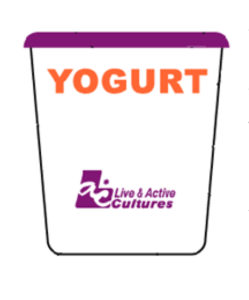
Often times, people question the health benefits of this delicious treat. How can something so sweet and mouth-watering be that great for you? Well, it is all thanks to little bacterium known as live and active cultures. Here are some common questions that you may find yourself asking, and we have the answers!

 The funny thing is, Soft Serve is never completely frozen; it simply contains ice crystals. The nutritional value of Soft Serve is based on the ingredients that the yogurt is made from, so it will vary for Soft Serve made by different companies. The labels should provide you with the nutritional information so you can see how they differ.
Yogurts and Soft Serve can contain live active cultures, but not all yogurts contain the extra probiotic bacteria. The flash-freezing technique used in the production of Soft Serve prevents the freezing cold conditions from killing the live cultures, which differs from the slow-freezing techniques championed by your average freezer. Flash-freezing the live cultures in the Soft Serve only makes the cultures dormant and does not kill them. However, the number of bacteria in frozen yogurt is usually lower than in the yogurt it was made from. Different yogurts and frozen yogurts are made with varied types of live cultures and probiotics. So with that said, the levels that remain in frozen yogurt depend highly upon the numbers that were in the yogurt to begin with and on the condition of the specific bacteria that was used.
The National Yogurt Association is the sponsor of a labeling program for Soft Serve called the “Live and Active Cultures” seal which can be found on containers of frozen yogurt. The Association and its seal sets the standard for a live and active cultures at 10 million cultures per gram for frozen yogurt at the time of manufacture, and 100 million cultures per gram for non-frozen yogurt. If the yogurt does not have the label, you can contact the manufacturer and ask what types of bacteria their product contains and at what level.
The funny thing is, Soft Serve is never completely frozen; it simply contains ice crystals. The nutritional value of Soft Serve is based on the ingredients that the yogurt is made from, so it will vary for Soft Serve made by different companies. The labels should provide you with the nutritional information so you can see how they differ.
Yogurts and Soft Serve can contain live active cultures, but not all yogurts contain the extra probiotic bacteria. The flash-freezing technique used in the production of Soft Serve prevents the freezing cold conditions from killing the live cultures, which differs from the slow-freezing techniques championed by your average freezer. Flash-freezing the live cultures in the Soft Serve only makes the cultures dormant and does not kill them. However, the number of bacteria in frozen yogurt is usually lower than in the yogurt it was made from. Different yogurts and frozen yogurts are made with varied types of live cultures and probiotics. So with that said, the levels that remain in frozen yogurt depend highly upon the numbers that were in the yogurt to begin with and on the condition of the specific bacteria that was used.
The National Yogurt Association is the sponsor of a labeling program for Soft Serve called the “Live and Active Cultures” seal which can be found on containers of frozen yogurt. The Association and its seal sets the standard for a live and active cultures at 10 million cultures per gram for frozen yogurt at the time of manufacture, and 100 million cultures per gram for non-frozen yogurt. If the yogurt does not have the label, you can contact the manufacturer and ask what types of bacteria their product contains and at what level.
 Yogurt is made by culturing dairy ingredients with bacterial cultures. The words “live and active cultures” refer to the living organisms, Lactobacillus Bulgaricus and Streptococcus Thermophilus, which convert pasteurized milk into yogurt during fermentation. (It is important to note that the milk is pasteurized before culturing in order to remove any harmful bacteria.) This fermentation process is what creates the yogurt we eat, with its tart taste, smooth texture, and hearty attributes. The yogurt cultures make up about 1% of the total ingredients, and because of these live and active cultures, some frozen yogurts may even be a better source of probiotics than some regular yogurts.
Yogurt is made by culturing dairy ingredients with bacterial cultures. The words “live and active cultures” refer to the living organisms, Lactobacillus Bulgaricus and Streptococcus Thermophilus, which convert pasteurized milk into yogurt during fermentation. (It is important to note that the milk is pasteurized before culturing in order to remove any harmful bacteria.) This fermentation process is what creates the yogurt we eat, with its tart taste, smooth texture, and hearty attributes. The yogurt cultures make up about 1% of the total ingredients, and because of these live and active cultures, some frozen yogurts may even be a better source of probiotics than some regular yogurts.
Check out our Featured Products HERE!

 The acceptable level for frozen yogurt is 10 million cultures per gram at the time of manufacture. This amount was agreed upon by research scientists who participated in studies of the health benefits of live cultures in yogurt products. All frozen yogurts are not created equally. Some lack fermentation and some are heat-treated after culturing, which will kill the cultures. Some others add additional cultures and do not use the fermentation process at all. To help you identify those yogurt products that contain live and active cultures, look for the National Yogurt Association (NYA) Live & Active Cultures seal. This is important to recognize because there is significant evidence suggesting that live cultures in regular yogurt and frozen yogurt can boost your immune system, prevent osteoporosis, and prevent gastrointestinal infections, ultimately helping your digestive system as a whole.
The acceptable level for frozen yogurt is 10 million cultures per gram at the time of manufacture. This amount was agreed upon by research scientists who participated in studies of the health benefits of live cultures in yogurt products. All frozen yogurts are not created equally. Some lack fermentation and some are heat-treated after culturing, which will kill the cultures. Some others add additional cultures and do not use the fermentation process at all. To help you identify those yogurt products that contain live and active cultures, look for the National Yogurt Association (NYA) Live & Active Cultures seal. This is important to recognize because there is significant evidence suggesting that live cultures in regular yogurt and frozen yogurt can boost your immune system, prevent osteoporosis, and prevent gastrointestinal infections, ultimately helping your digestive system as a whole.
















